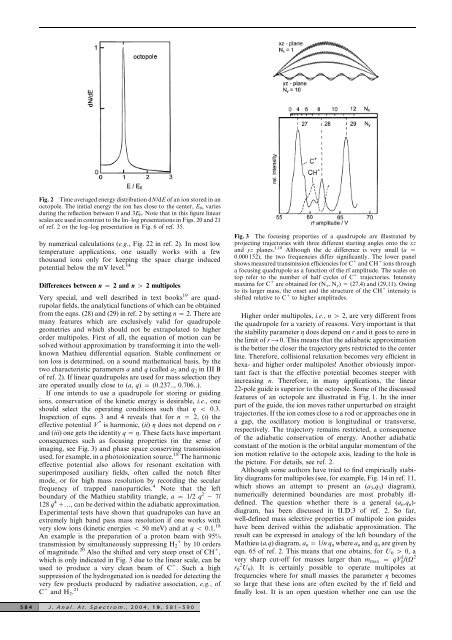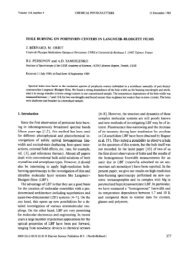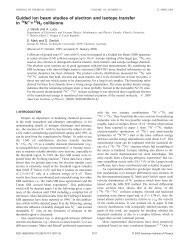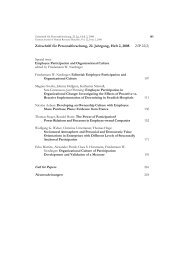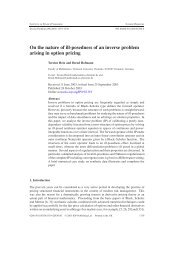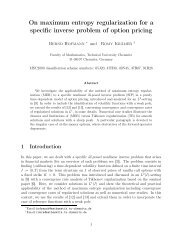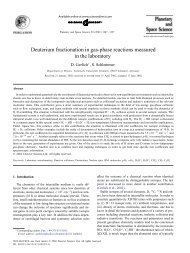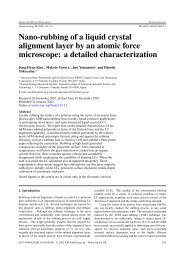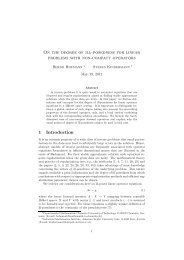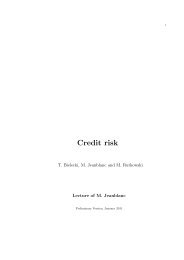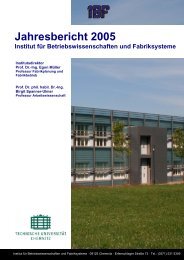Applications of rf fields and collision dynamics in atomic mass ...
Applications of rf fields and collision dynamics in atomic mass ...
Applications of rf fields and collision dynamics in atomic mass ...
Create successful ePaper yourself
Turn your PDF publications into a flip-book with our unique Google optimized e-Paper software.
Fig. 2 Time averaged energy distribution dN/dE <strong>of</strong> an ion stored <strong>in</strong> an<br />
octopole. The <strong>in</strong>itial energy the ion has close to the center, E0, varies<br />
dur<strong>in</strong>g the reflection between 0 <strong>and</strong> 3E0. Note that <strong>in</strong> this figure l<strong>in</strong>ear<br />
scales are used <strong>in</strong> contrast to the l<strong>in</strong>–log presentations <strong>in</strong> Figs. 20 <strong>and</strong> 21<br />
<strong>of</strong> ref. 2 or the log–log presentation <strong>in</strong> Fig. 6 <strong>of</strong> ref. 35.<br />
by numerical calculations (e.g., Fig. 22 <strong>in</strong> ref. 2). In most low<br />
temperature applications, one usually works with a few<br />
thous<strong>and</strong> ions only for keep<strong>in</strong>g the space charge <strong>in</strong>duced<br />
potential below the mV level. 14<br />
Differences between n ~ 2 <strong>and</strong> n w 2 multipoles<br />
Very special, <strong>and</strong> well described <strong>in</strong> text books 19 are quadrupolar<br />
<strong>fields</strong>, the analytical functions <strong>of</strong> which can be obta<strong>in</strong>ed<br />
from the eqns. (28) <strong>and</strong> (29) <strong>in</strong> ref. 2 by sett<strong>in</strong>g n ~ 2. There are<br />
many features which are exclusively valid for quadrupole<br />
geometries <strong>and</strong> which should not be extrapolated to higher<br />
order multipoles. First <strong>of</strong> all, the equation <strong>of</strong> motion can be<br />
solved without approximation by transform<strong>in</strong>g it <strong>in</strong>to the wellknown<br />
Mathieu differential equation. Stable conf<strong>in</strong>ement or<br />
ion loss is determ<strong>in</strong>ed, on a sound mathematical basis, by the<br />
two characteristic parameters a <strong>and</strong> q (called a2 <strong>and</strong> q2 <strong>in</strong> III B<br />
<strong>of</strong> ref. 2). If l<strong>in</strong>ear quadrupoles are used for <strong>mass</strong> selection they<br />
are operated usually close to (a, q) ~ (0.237.., 0.706..).<br />
If one <strong>in</strong>tends to use a quadrupole for stor<strong>in</strong>g or guid<strong>in</strong>g<br />
ions, conservation <strong>of</strong> the k<strong>in</strong>etic energy is desirable, i.e., one<br />
should select the operat<strong>in</strong>g conditions such that g v 0.3.<br />
Inspection <strong>of</strong> eqns. 3 <strong>and</strong> 4 reveals that for n ~ 2, (i) the<br />
effective potential V * is harmonic, (ii) g does not depend on r<br />
<strong>and</strong> (iii) one gets the identity q ~ g. These facts have important<br />
consequences such as focus<strong>in</strong>g properties (<strong>in</strong> the sense <strong>of</strong><br />
imag<strong>in</strong>g, see Fig. 3) <strong>and</strong> phase space conserv<strong>in</strong>g transmission<br />
used, for example, <strong>in</strong> a photoionization source. 18 The harmonic<br />
effective potential also allows for resonant excitation with<br />
superimposed auxiliary <strong>fields</strong>, <strong>of</strong>ten called the notch filter<br />
mode, or for high <strong>mass</strong> resolution by record<strong>in</strong>g the secular<br />
frequency <strong>of</strong> trapped nanoparticles. 4 Note that the left<br />
boundary <strong>of</strong> the Mathieu stability triangle, a ~ 1/2 q 2 2 7/<br />
128 q 4 1…, can be derived with<strong>in</strong> the adiabatic approximation.<br />
Experimental tests have shown that quadrupoles can have an<br />
extremely high b<strong>and</strong> pass <strong>mass</strong> resolution if one works with<br />
very slow ions (k<strong>in</strong>etic energies v 50 meV) <strong>and</strong> at q v 0.1. 18<br />
An example is the preparation <strong>of</strong> a proton beam with 95%<br />
transmission by simultaneously suppress<strong>in</strong>g H2 1 by 10 orders<br />
<strong>of</strong> magnitude. 20 Also the shifted <strong>and</strong> very steep onset <strong>of</strong> CH 1 ,<br />
which is only <strong>in</strong>dicated <strong>in</strong> Fig. 3 due to the l<strong>in</strong>ear scale, can be<br />
used to produce a very clean beam <strong>of</strong> C 1 . Such a high<br />
suppression <strong>of</strong> the hydrogenated ion is needed for detect<strong>in</strong>g the<br />
very few products produced by radiative association, e.g., <strong>of</strong><br />
C 1 <strong>and</strong> H2. 21<br />
584 J. Anal. At. Spectrom., 2004, 19, 581–590<br />
Fig. 3 The focus<strong>in</strong>g properties <strong>of</strong> a quadrupole are illustrated by<br />
project<strong>in</strong>g trajectories with three different start<strong>in</strong>g angles onto the xz<br />
<strong>and</strong> yz planes. 1,18 Although the dc difference is very small (a ~<br />
0.000 152), the two frequencies differ significantly. The lower panel<br />
shows measured transmission efficiencies for C 1 <strong>and</strong> CH 1 ions through<br />
a focus<strong>in</strong>g quadrupole as a function <strong>of</strong> the <strong>rf</strong> amplitude. The scales on<br />
top refer to the number <strong>of</strong> half cycles <strong>of</strong> C 1 trajectories. Intensity<br />
maxima for C 1 are obta<strong>in</strong>ed for (Nx, Ny) ~ (27,4) <strong>and</strong> (29,11). Ow<strong>in</strong>g<br />
to its larger <strong>mass</strong>, the onset <strong>and</strong> the structure <strong>of</strong> the CH 1 <strong>in</strong>tensity is<br />
shifted relative to C 1 to higher amplitudes.<br />
Higher order multipoles, i.e., n w 2, are very different from<br />
the quadrupole for a variety <strong>of</strong> reasons. Very important is that<br />
the stability parameter g does depend on r <strong>and</strong> it goes to zero <strong>in</strong><br />
the limit <strong>of</strong> r A 0. This means that the adiabatic approximation<br />
is the better the closer the trajectory gets restricted to the center<br />
l<strong>in</strong>e. Therefore, <strong>collision</strong>al relaxation becomes very efficient <strong>in</strong><br />
hexa- <strong>and</strong> higher order multipoles! Another obviously important<br />
fact is that the effective potential becomes steeper with<br />
<strong>in</strong>creas<strong>in</strong>g n. Therefore, <strong>in</strong> many applications, the l<strong>in</strong>ear<br />
22-pole guide is superior to the octopole. Some <strong>of</strong> the discussed<br />
features <strong>of</strong> an octopole are illustrated <strong>in</strong> Fig. 1. In the <strong>in</strong>ner<br />
part <strong>of</strong> the guide, the ion moves rather unperturbed on straight<br />
trajectories. If the ion comes close to a rod or approaches one <strong>in</strong><br />
a gap, the oscillatory motion is longitud<strong>in</strong>al or transverse,<br />
respectively. The trajectory rema<strong>in</strong>s restricted, a consequence<br />
<strong>of</strong> the adiabatic conservation <strong>of</strong> energy. Another adiabatic<br />
constant <strong>of</strong> the motion is the orbital angular momentum <strong>of</strong> the<br />
ion motion relative to the octopole axis, lead<strong>in</strong>g to the hole <strong>in</strong><br />
the picture. For details, see ref. 2.<br />
Although some authors have tried to f<strong>in</strong>d empirically stability<br />
diagrams for multipoles (see, for example, Fig. 14 <strong>in</strong> ref. 11,<br />
which shows an attempt to present an (a3,q3) diagram),<br />
numerically determ<strong>in</strong>ed boundaries are most probably illdef<strong>in</strong>ed.<br />
The question whether there is a general (an,qn)diagram,<br />
has been discussed <strong>in</strong> II.D.3 <strong>of</strong> ref. 2. So far,<br />
well-def<strong>in</strong>ed <strong>mass</strong> selective properties <strong>of</strong> multipole ion guides<br />
have been derived with<strong>in</strong> the adiabatic approximation. The<br />
result can be expressed <strong>in</strong> analogy <strong>of</strong> the left boundary <strong>of</strong> the<br />
Mathieu (a,q) diagram, a n ~ 1/nq n where a n <strong>and</strong> q n are given by<br />
eqn. 65 <strong>of</strong> ref. 2. This means that one obta<strong>in</strong>s, for U0 w 0, a<br />
very sharp cut-<strong>of</strong>f for <strong>mass</strong>es larger than mmax ~ qV 2 0 /(V2<br />
r0 2 U0). It is certa<strong>in</strong>ly possible to operate multipoles at<br />
frequencies where for small <strong>mass</strong>es the parameter g becomes<br />
so large that these ions are <strong>of</strong>ten excited by the <strong>rf</strong> field <strong>and</strong><br />
f<strong>in</strong>ally lost. It is an open question whether one can use the


